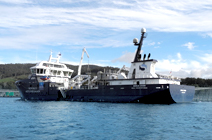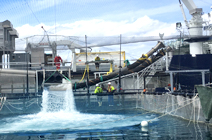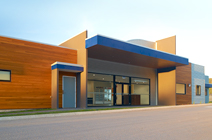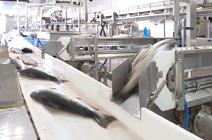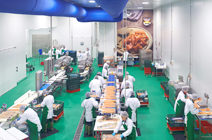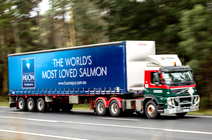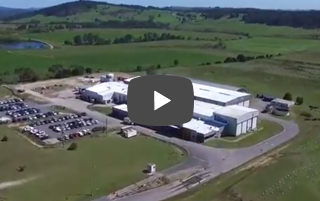
TASMANIA-The ideal place for Huon Salmon.

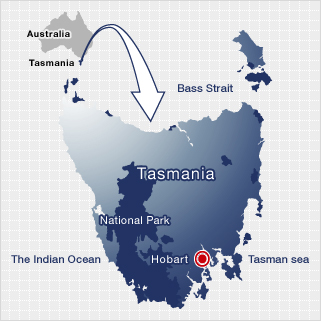
Located in the South-East of Australia, Tasmania is a land of mild marine climate.
Tasmania is an island state located 240km off the South East shore of mainland Australia. It is between south latitude 40 to 43.5 degrees, and is the right opposite to Hokkaido, with the equator being the center. However, different to Hokkaido, Tasmania is known for its year round mild and calm marine climate condition. The island is surrounded by the Indian Ocean on the South West coast, Tasman Sea on the East coast, and the North by Bass Strait separating Tasmania from the mainland. Tasmania has an area of 67,800 square kilometers and is a touch smaller than Hokkaido, representing about 1% of the entire Australia in land mass. The population is approximately 480,000, and is the smallest of all states.Capital city is Hobart.
Premium Tasmanian Salmon Brand : Huon Aquaculture Group.

Striving for excellence, is the mantra of Peter and Frances Bender when they started salmon farming in 1988. Peter and Frances chose to locate their headquarters in the pristine and rugged environment where the water from the Tasmanian Wilderness World Heritage Area flows to, to produce the best product possible. Huon Salmon is grown with care under this pristine environment. With Huon’s unique techniques such as the feeding system, fallowing periods and other technologies unheard of in other salmon farming regions, Huon is able to provide and deliver the best salmon to many consumers around the globe.
Features
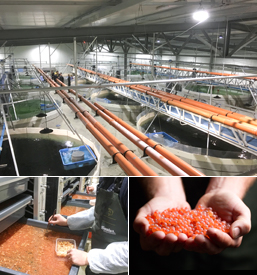
Huon has been working on improving selective breeds since 2002 and has set standards for strength, growth rate, flesh color, etc to be able to supply stable quality throughout the year. We have succeeded not only in improving the growth rate and color stability but also in growing stable sizes and improving each year. In addition, starting with its own hatchery first constructed and operational since 2008, in 2014, the company began its operation of their second large hatchery, and in 2018, completed their first intermediate freshwater farming site. Huon contiunes to focus on stable production of eggs and smolts to aim for further improvement on size and supply.
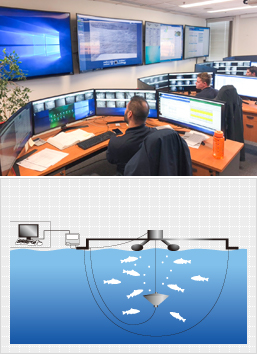
Feeding is done remotely from the feeding center room at the Huon headquarters. This high-tech system enables for the salmon to be fed on demand with high quality underwater cameras and motion sensors attached to each cage. This system makes it possible to feed salmon safely and surely even in bad weather or rough waters. This also enables to grow salmon at a consistant pace for stable quality and supply.
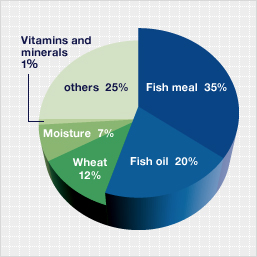
Fish meals and fish oils are the essentials when farming superior and healthy salmon. After repeating trials, Huon has determined the most efficient ratio to be used in the feed. Fish meals provide health and fish oil provide fat to the salmon. With this original ratio, Huon is able to farm healthy fish in summer time when the fish tend to weaken and less resistant to deceases. Also, by reducing the amount of fish oil compared to other farmed salmon, Huon's fish taste is non-fatty, and very good for sashimi and sushi.
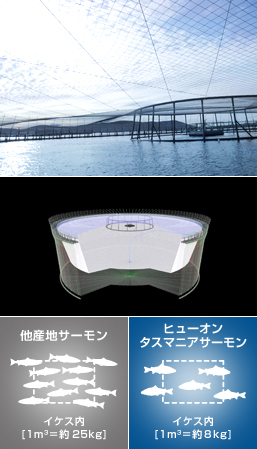
Since 2014, Huon has switched all of their pens to a newly designed “Fortress” pen, which consists of dual net structure made from heavy strength materials. The nets use a special material called Kevlar, which is also used in the bulletproof vests, not only protects the salmon from seals, but also provides strength to withstand the rough environment in the open sea and bad weather. Stocking density is unchanged from the start of the company and kept at 8 kg / m 3 in summer, and 11 kg / m 3 in winter, and is the lowest in the world. Furthermore, by enlarging the size of the “Fortress” pens to a circumference of 240 m and a diameter of 76m, provides more space for the fish and reduces stress for improved quality.

Huon regularly changes the area of farming according to season and fish growth. Efforts are put in to maintain optimal enviornment by giving each areas fallowing periods. In addition to fallowing and further concerns to the environment, Huon is moving their sites to more open waters for farming at higher energy sites. Although going out to the open sea makes the salmon more vulnerable to bad weather and tide flow, it is an ideal environment for the salmon and environmentally friendly.
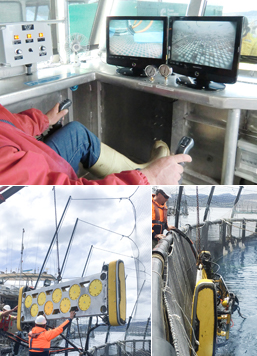
Until recently, nets were changed regularly. Algae, seaweed, mussels, etc adhere to the nets, and the oxygen concentration in the cage falls, so net changes were done frequently. However in recent years, the size of the fish pens has become much larger, and with the use of new matierals that minimize the the adhesion of foreign objects with double netting, the necessity to periodically change the nets is no longer required. However, because the nets still become dirty and regular cleaning is still necessary, Huon uses a remote control net cleaner to do the job. This net cleaner which can move freely up and down, right and left, uses water pressure to clean the nets while allowing the controls to be done on board a ship equipped with a remote control and monitors for cameras. With this, the nets are kept clean and provides a better enviornment for the salmon.

Tasmania salmon, unlike other production areas, has a maturing period of one year after being put to sea. Therefore it has always a challenge to supply fish of stable size throughout the year. Adjustments based on various data such as hatching time temperature control at the hatchery, extension of freshwater farming period, use of underwater lights to mimic day time to slow growth, change of farming sites, etc. is what we currently do to provide stable quality and size throughout the year.
During the ealry stages, each pen was towed from the sites to harvest port by boat, but with the launch of the "Ronja Huon" in 2014, a state of the art well boat, we can now move the fish live from the pen directly into the tank inside the boat and off load at the the harvest pens. The Ronja Huon can transport 300t of live salmon at one time and is the largest of this kind. After transferring to the harvest pens prior to acutal harvest, the fish go through a starvation period for about 7 days while reducing the stress from transportation. During the harvest, the salmon is sucked by a large hydraulic pump to the stunning table where a automatic stunning machine (head blow) and an automatic gill cutting machine kill and bleed the fish instantly. After bleeding, the fish are transferred to a special tanker dedicated to salmon transportation. These tankers are a one of a kind truck, and developed jointly by Huon and the shipping company. The large stainless steel tanker is equipped with water cooling and a circulator unit to maintain water temperature at 0 degrees C and the salmon are super chilled during the transport to the factory. After the salmon arrives at Huon's state-of-the-art processing factory about 6 hours from harvest, the salmon is transferred directly from the tankers into the factory through a pump. Once into the factory, guts are removed and graded for size and quality. It is then packed in export box with ice into the storage area for pick up by refridgerated truck. The time from fish coming into the factory and into the export boxes can be short as 5 minutes, and all fish are processed pre-rigor.
Huon with its selective breeding and unique farming technologies, have a small head, and firm body texture. With this, recovery rate from fish to fillets have proven to be over 5% better than other region salmon. The pre-rigor process also enables the fish to lessen gapping while delivering a great texture salmon.

| Region | Head | Fillet | |
|---|---|---|---|
| Huon Salmon | 5.4%(245g) | Fillet 1:1,930g Fillet 2:1,880g |
Total:84.2%(3.810g) |
| Salmon A | 11.5%(535g) | Fillet 1:1,815g Fillet 2:1,785g |
Total:77.2%(3,600g) |
| Salmon B | 9.1%(410g) | Fillet 1:1,790g Fillet 2:1,795g |
Total:79.7%(3,585g) |
| Salmon C | 10.4%(485g) | Fillet 1:1,865g Fillet 2:1,785g |
Total:78.2%(3,650g) |










